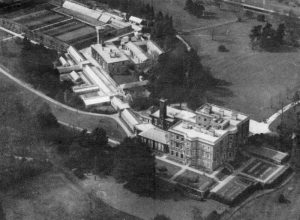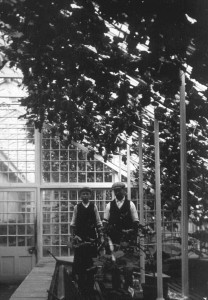
The extensive run of glasshouses are visible running towards the top left of the picture (Ranmore Archive). For an enlarged version, click here.
The gardens at Denbies were already very extensive and well planned when Thomas Cubitt purchased the property, but with great enthusiasm he set about improving the woods and gardens. He planted on a grand scale, thousands of trees, including many conifers. He took advice from Prince Albert and probably obtained the rarer shrubs and plants from his friend Sir William Hooker, Director of Kew Gardens. A most remarkable feature was the range of glasshouses extending nearly a quarter of a mile (1230 feet) from the house. These were packed with temperate, subtropical and tropical plants, as well as orange trees, plums, cherries, peaches, nectarines and grape vines. Outside the glasshouses and throughout the gardens were many fine trees and shrubs, and a notable fernery.

A small corner of the elaborate Denbies Gardens, with the beginning of the run of a quarter-mile of glasshouses (Ranmore Archive)
The main flower garden was on the terrace adjoining the Mansion. At the end of the glasshouses was a Mushroom House and there was a walled kitchen garden of about two acres, with fruit trees trained on the walls. In Thomas’s great-grandson Stephen Tallents’ day (1890s), the extensive lawns around the house were cut by a mower drawn by a horse, wearing leather overshoes so as not to leave hoofmarks on the greensward.
There are very detailed descriptions of the gardens and glasshouses in the 1867 and 1876 issues of the “Journal of Horticulture and Cottage [!] Gardener” quoted on pages 81-4 of “The House on the Hill” by S.E.D.Fortescue (see “Sources” below). The Journal pays tribute to head gardeners in the respective years – Mr Drewett, and Mr Beesley, who “with that modesty usually attending merit … is anxious that whatever credit his charge exemplifies should be given first to a liberal owner, and next to his honoured predecessor, Mr Drewett under whom he served for so many years.”

Denbies garden staff c. 1860 (Dorking Museum). Probably Messrs Drewett and Beesley are among them?

Garden boy and gardener c. 1912 (Ranmore Archive)
With all this to maintain, it is not surprising that, even in the 1930s, the head gardener had the help of fourteen undergardeners, the unmarried ones living in a well-appointed gardeners’ bothy with comfortable beds, means of cooking their food, and a library for them to read in. In the 1911 census Frank Woodman of the War Memorial is living there.
Among Frank Woodman’s effects when he died in WW1 is the not-very-sharp photograph below. As Frank spent his working life at Denbies, this is probably the inside of the huge glass conservatory or one of the glasshouses, set out for some function: the Harvest Home dinner was held in the conservatory, perhaps a similar occasion. Any thoughts on this intriguing picture would be appreciated – please contact us,

Mystery picture, shown by kind permission of Frank Woodman’s grandchildren
SOURCES
This is a composite list of the sources consulted. Many can be viewed online via Ancestry, Find My Past and Free BMD
Birth, death and marriage registers and certificates, General Register Office (GRO)
Baptism, marriage, burial registers, St Barnabas Ranmore Common, Surrey History Centre (SHC)
Censuses 1841-1911, The National Archives (TNA)
Post Office Directories, UK City and County Directories 1600-1900s
“Man and Boy”, Sir Stephen Tallents, Faber and Faber, 1943
“Edwardian Daughter”, Sonia Keppel, Hamish Hamilton, 1958
“The House on the Hill, The Story of Ranmore and Denbies”, S.E.D.Fortescue, Denbies Wine Estate, 1993
“Thomas Cubitt, Master Builder”, Hermione Hobhouse, Macmillan London 1971, reissued Managemens Books Ltd. 1991
Copyright©2016